-
| | Signal Flies - Family Platystomatidae
- This page contains pictures and information about Signal
Flies in Family Platystomatidae that we found in the Brisbane area, Queensland, Australia.
-
 -
- In Australia, the Platystomatidae (Signal Flies) are a large family in acalypterate
group.
Most flies in this family feed on mammalian faeces, some attend flowers or
decaying fruits. Their larvae habits are
varied. Some lives in plant trunk damaged by other insects or fungi. Some feed
on rotting vegetable. Not much other details about the larvae is known.
-
- Adult Signal Flies are medium in size, usually they have at least some dots or patterns
on wings. Some species are metallic colours. Most species adults can
only be seen during summer time in Brisbane.
-
- The Signal Flies are usually found on tree trunks or on leaves where may be
a place for courtship. Sometimes a small group of them can be found at one point.
While walking on those surface, Signal Flies exhibit a characteristic manner
of movement, something like dancing in our human eyes. Those movements include
rowing or extend of wings, waving of front pair of legs, move forwards and
backwards, extend and raise of proboscis.
-
- This group of flies contains the spectacular Achias species, the stalk-eyed signal
flies. The males have eyes on long stalks extending from either side of their
heads. However, they were the tropical species and we never saw them in Brisbane.
-
Subfamily Platystomatinae
- All Signal Fly species we found are all in this
subfamily Platystomatinae.
-
- Orange-blue Signal Fly
  - Lamprogaster bicolor, body length
10mm
- We saw a few of this flies dancing on gum tree trunk. Pictures were taken
in Karawatha Forest during mid summer. Head and throax of the fly are orange
colour with abdomen in dark metallic blue. Wings are patterned with black
spots, leading edge and wing base are orange. Legs are pale orange in colour.
Please check this page for more
information.
-
-
- Orange-green Signal Fly
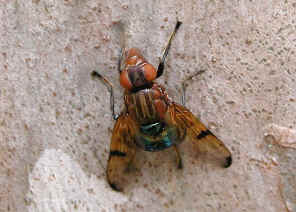 
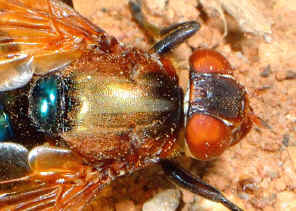 - Lamprogaster corusca, body length 8mm
- Head and thorax of this fly are orange colour with abdomen in metallic
green. Wings are patterned with black spots, leading edge and wing base are
orange. Legs are black in colour. Please
also check this page for more
information.
-
-
- Green Signal Fly
 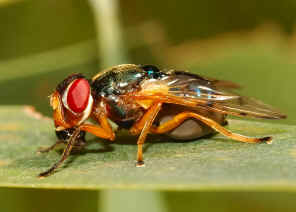 - Lamprogaster imperialis, body length 8mm
- Abdomen and thorax of this fly are metallic green, with red eyes on black
head. Wings are patterned with black spots, leading edge and wing base are
pale orange. Legs are also pale orange in colour. We have more pictures
and information in this page.
-
-
- Boatman Fly
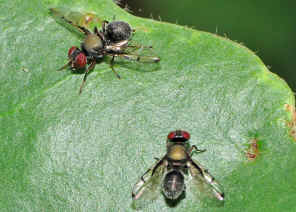
 - Pogonortalis doclea, body length 5mm
- This fly, when walking, swings it wings like someone swinging the paddles
when rowing a boat. We believed this is why they are called Boatman Fly. This
fly is small in size, walk with wing open and has the narrowed waist. We
believed this fly mimic ant.
Please check this page for more pictures and
information.
-
-
- Brown-banded Signal Fly I
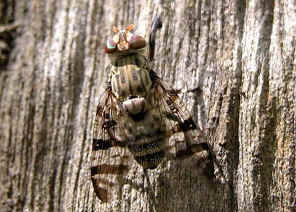 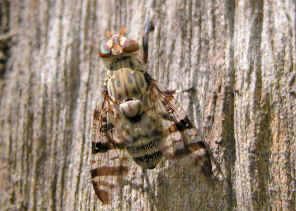 - Euprosopia armipes, body length 10mm
- The fly is pale brown in colour with brown banded patterns on wings and
abdomen. Eyes and all legs are Brown as well.
Picture is taken in Alexandra Hill, mid summer. Please check this page
for more infromation.
-
-
- Brown-banded Signal Fly II
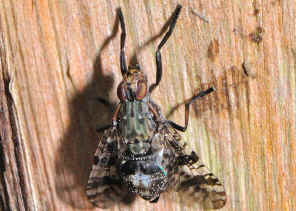
 - Euprosopia sp., body length 8mm
- The fly is dark brown in colour with dark brown banded patterns on wings. Eyes and all legs are
dark brown as well. Please check this page
for more information.
-
-
- Black-banded Signal Fly

  - Euprosopia tenuicornis, body length 10mm
- The fly is grey in colour with black banded patterns on wings and
abdomen. Eyes and all legs are black. Please check this page
for more information.
-
- Reference:
- 1. Insects
of Australia - CSIRO, Division of Entomology, Melbourne University
Press, 2nd Edition 1991, p770.
- 2. The Australian Platystomatidae (Diptera, Schizophora) with a revision of five genera -
McAlpine, D.K., 1972, The Australian Museum.
- 3. Review of the Australasian Genera of Signal Flies (Diptera: Platystomatidae) - DAVID K. MCALPINE, Records of the Australian Museum 53(2): 113–199,
2001.
- 4. Family PLATYSTOMATIDAE - Australian Biological Resources Study, Australian Faunal Directory.
- 5. On
the Fly, The Interactive Atlas and Key to Australian Fly Families CD Rom
- Hamilton, J. et al. 2006. Brisbane : CBIT & ABRS.
-
[ Up ] [ Sepsidae ] [ Lauxaniidae ] [ Micropezidae ] [ Agriomyzidae ] [ Milichiidae & Chloropidae ] [ Platystomatidae ] [ Pyrgotidae ] [ Tephritidae ] [ Ephydridae ] [ Drosophilidae ] [ Unknown Acalyptrata Flies ]
| |
|
















